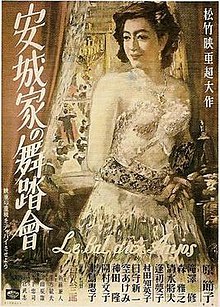fiction.wikisort.org - Movie
The Ball at the Anjo House (安城家の舞踏会, Anjō-ke no butōkai) is a 1947 Japanese drama film directed by Kōzaburō Yoshimura.[1][2][3] The film won the 1947 Kinema Junpo Award for Best Film.[4]
| The Ball at the Anjo House | |
|---|---|
 Original Japanese theatrical poster. | |
| Directed by | Kōzaburō Yoshimura |
| Written by |
|
| Produced by | Takeshi Ogura |
| Starring | |
| Cinematography | Toshio Ubukata |
| Edited by | Yoshi Sugihara |
| Music by | Chuji Kinoshita |
Production company | Shochiku |
| Distributed by | Shochiku |
Release date |
|
Running time | 89 minutes |
| Country | Japan |
| Language | Japanese |
Plot
After Japan's defeat in the Pacific War, the wealthy Anjō family have to give up their mansion and their way of life in the wake of the post-war agrarian reform. While the widowed father Tadahiko grieves for the lost social status, and both the cynical son Masahiko and the older sister show only contempt for their lower-class ex-lovers who they dropped, the younger daughter Atsuko accepts the new circumstances and tries to find her own place in the new Japan. Tadahiko decides to hold one last ball at the house before leaving, which results in numerous confrontations, including Tadahiko and ruthless businessman Shinkawa, to whom he is indebted, and Masahiko and his fiancée Yōko, Shinkawa's daughter. Towards the end of the festivity, Tadahiko officially presents his geisha mistress as his life partner to the noble guests. After the ball has ended, he tries to commit suicide, but is held back by Atsuko.
Cast
- Setsuko Hara as Atsuko Anjō
- Osamu Takizawa as Tadahiko Anjō
- Masayuki Mori as Masahiko Anjō
- Yumeko Aizome as Akiko Anjō
- Masao Shimizu as Ryūzaburō Shinkawa
- Keiko Tsushima as Yōko Shinkawa
- Chieko Murata as Chiyo
Legacy
The British Film Institute included The Ball at the Anjo House in its "Best Japanese film of every year" list, pointing out the film's "inventive camerawork" and "superb performances", in particular those by Setsuko Hara and Masayuki Mori, and calling it "stylish", "moving" and "inteligent".[3] Film historian Donald Richie drew parallels between Kaneto Shindō's script and Anton Chekhov's The Cherry Orchard in his book A Hundred Years of Japanese Film.[5]
Awards
- 1948: Kinema Junpo Award for Best Film of the Year
- 1948: Mainichi Film Award for Best Actor Masayuki Mori[4]
References
- "安城家の舞踏会 (Anjō-ke no butōkai)" (in Japanese). Kinenote. Retrieved 3 January 2022.
- "安城家の舞踏会 (Anjō-ke no butōkai)" (in Japanese). Japanese Movie Database. Retrieved 3 January 2022.
- "The Best Japanese Film of Every Year – From 1925 to Now". British Film Institute. Retrieved 3 January 2022.
- "Anjô-ke no butôkai: Awards". Internet Movie Database. Retrieved 27 January 2015.
- Richie, Donald (2005). A Hundred Years of Japanese Film (Revised ed.). Tokyo, New York, London: Kodansha International. p. 112. ISBN 978-4-7700-2995-9.
External links
- The Ball at the Anjo House at IMDb
На других языках
- [en] The Ball at the Anjo House
[ru] Бал в доме Андзё
«Бал в доме Андзё» (яп. 安城家の舞踏会: андзё кэ-но бутокай; англ. A Ball at the Anjo House) — японский чёрно-белый фильм-драма, поставленный режиссёром Кодзабуро Ёсимурой в 1947 году. «Бал в доме Андзё» был назван лучшим фильмом 1947 года на церемонии вручения премий журнала «Кинэма Дзюмпо». Кинолента занимает 34 место в списке 150-ти лучших японских фильмов по результатам голосования, проведённого в 1989 году среди читателей издания «Бунгэй сюндзю[en]». А по опросам среди ведущих кинокритиков популярного японского журнала о кино «Кинэма Дзюмпо», проводившихся в 1995, 1999 и 2009 гг. с той же целью — создание списка лучших японских кинолент за всё время развития национального кинематографа, фильм неуклонно продвигался в рейтинге вверх: в 1995-м — 77 место; в 1999-м — 49 место; в 2008-м — 36 место.Другой контент может иметь иную лицензию. Перед использованием материалов сайта WikiSort.org внимательно изучите правила лицензирования конкретных элементов наполнения сайта.
WikiSort.org - проект по пересортировке и дополнению контента Википедии